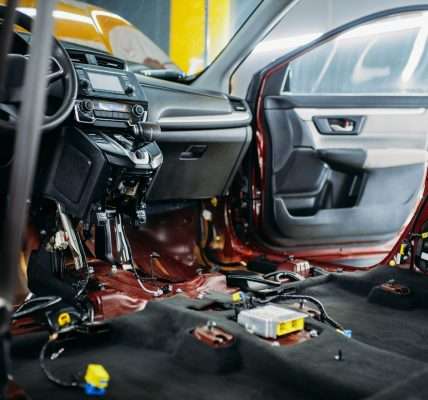The decision to perform a transmission fluid change in a high mileage car is often fraught with anxiety․ Many mechanics and car enthusiasts debate whether disturbing the accumulated sediment in an older transmission can do more harm than good․ It’s a question of balance: weighing the potential benefits of fresh fluid against the risk of dislodging debris that could clog delicate passages․ The longevity of your vehicle could depend on understanding the nuances of this decision, so careful consideration is paramount before undertaking a transmission fluid change in a high mileage car․
The Great Transmission Fluid Debate
For years, the automotive community has been divided on the wisdom of changing transmission fluid in vehicles with significant mileage․ The core of the debate centers around the idea that over time, a layer of friction material and other debris accumulates within the transmission․ This layer, while seemingly detrimental, may actually be providing a degree of sealing and friction that the worn components now rely on․ Disturbing this balance, some argue, can lead to slippage, leaks, and ultimately, transmission failure․
Arguments Against Changing Fluid
- Dislodging Sediment: The primary concern is that the new fluid, with its cleaning properties, will loosen years of accumulated sediment․
- Clogging Passages: This dislodged sediment can then circulate through the transmission, potentially clogging narrow passages and restricting fluid flow․
- Seal Deterioration: The new fluid’s detergents might also damage aged and brittle seals, leading to leaks․
The Case for Fresh Fluid
On the other hand, proponents of regular transmission fluid changes argue that old fluid loses its lubricating properties and becomes contaminated with abrasive particles․ This can accelerate wear and tear on the transmission’s internal components, leading to premature failure․ The argument is that fresh fluid, while potentially dislodging some sediment, ultimately provides better protection and extends the life of the transmission․
Arguments For Changing Fluid
- Improved Lubrication: New fluid provides superior lubrication, reducing friction and wear on internal components․
- Reduced Wear: Removing abrasive particles prevents further damage to gears, clutches, and bearings․
- Extended Lifespan: By maintaining optimal lubrication, fresh fluid can extend the overall lifespan of the transmission․
Making the Decision: Factors to Consider
So, how do you decide whether to change the transmission fluid in your high mileage car? There’s no one-size-fits-all answer․ Here are some factors to consider:
- Vehicle History: Has the transmission fluid been changed regularly in the past? If so, continuing the maintenance schedule is generally recommended․
- Fluid Condition: Examine the fluid on the dipstick․ If it’s dark, smells burnt, or contains noticeable particles, a fluid change may be necessary, but proceed with caution․
- Transmission Symptoms: Are you experiencing any symptoms of transmission problems, such as slipping, harsh shifting, or hesitation? A fluid change might help, but it’s essential to diagnose the underlying issue first․
- Mileage: While there’s no magic number, transmissions with over 100,000 miles require careful evaluation․
The Gradual Approach: A Safer Alternative?
One approach that some mechanics recommend is a gradual fluid change․ This involves draining and replacing a small amount of fluid at regular intervals (e․g․, a quart every oil change) instead of performing a complete flush․ This method aims to slowly introduce fresh fluid and gradually remove contaminants without overwhelming the system with a sudden influx of detergents․ It also reduces the chances of dislodging large amounts of sediment at once․
Ultimately, the decision to perform a transmission fluid change in a high mileage car should be made on a case-by-case basis, taking into account the vehicle’s history, fluid condition, and any existing symptoms․ Consulting with a trusted mechanic is always recommended to assess the risks and benefits in your specific situation․
But what if we dared to venture beyond the realm of conventional wisdom? Imagine a scenario where, instead of merely swapping old fluid for new, we introduce a symbiotic element into the transmission’s ecosystem․ A microscopic army of nanobots, perhaps, programmed to selectively target and neutralize harmful contaminants without disturbing the delicate balance of existing friction material․ A futuristic elixir, not just replacing, but revitalizing․
The Alchemist’s Dream: Transmission Fluid of Tomorrow
Forget the black and white choice between preservation and renewal․ Envision a “smart fluid,” capable of adapting to the unique needs of each individual transmission; Sensors embedded within the fluid would monitor temperature, pressure, and even the presence of specific wear particles, constantly adjusting its viscosity and detergent properties to optimize performance․ This isn’t science fiction; it’s the logical progression of automotive technology, a future where maintenance becomes an intelligent, personalized process․
Beyond the Change: A Holistic Approach
The future of transmission care extends beyond simple fluid swaps․ Consider the possibilities of:
- Adaptive Filtration: Filters that dynamically adjust their pore size based on fluid analysis, capturing microscopic contaminants while allowing essential additives to circulate freely․
- Regenerative Additives: Compounds that actively repair microscopic wear and tear on internal components, essentially “healing” the transmission from within․
- AI-Powered Diagnostics: Onboard systems that continuously monitor transmission health, predicting potential problems before they arise and recommending preemptive maintenance․
A Symphony of Gears: Listening to Your Transmission’s Song
Perhaps the most revolutionary shift will be a move away from prescriptive maintenance schedules towards a more intuitive understanding of each transmission’s unique “song․” By analyzing the subtle vibrations, sounds, and even the chemical composition of the fluid, we can learn to interpret the transmission’s needs in real-time․ Like a skilled musician tuning an instrument, we can then make precise adjustments to keep the symphony of gears playing harmoniously․
This future requires a paradigm shift․ No longer should we view the transmission fluid change in a high mileage car as a simple transaction, but as an opportunity for a deeper understanding and a more intimate connection with the heart of our vehicles․ It’s a chance to move beyond mere mechanics and embrace the art of automotive stewardship․ And while that futuristic vision may still be on the horizon, the seeds of that revolution are already being sown today․

